Improving Performance & Remuneration at O'Meara Electronics
VerifiedAdded on 2023/03/30
|7
|1337
|112
Case Study
AI Summary
This case study examines the performance and remuneration systems at O'Meara Electronics, a company facing declining profitability and market position. The current position-based remuneration system is identified as a contributing factor to reduced productivity and a disconnect between employe...
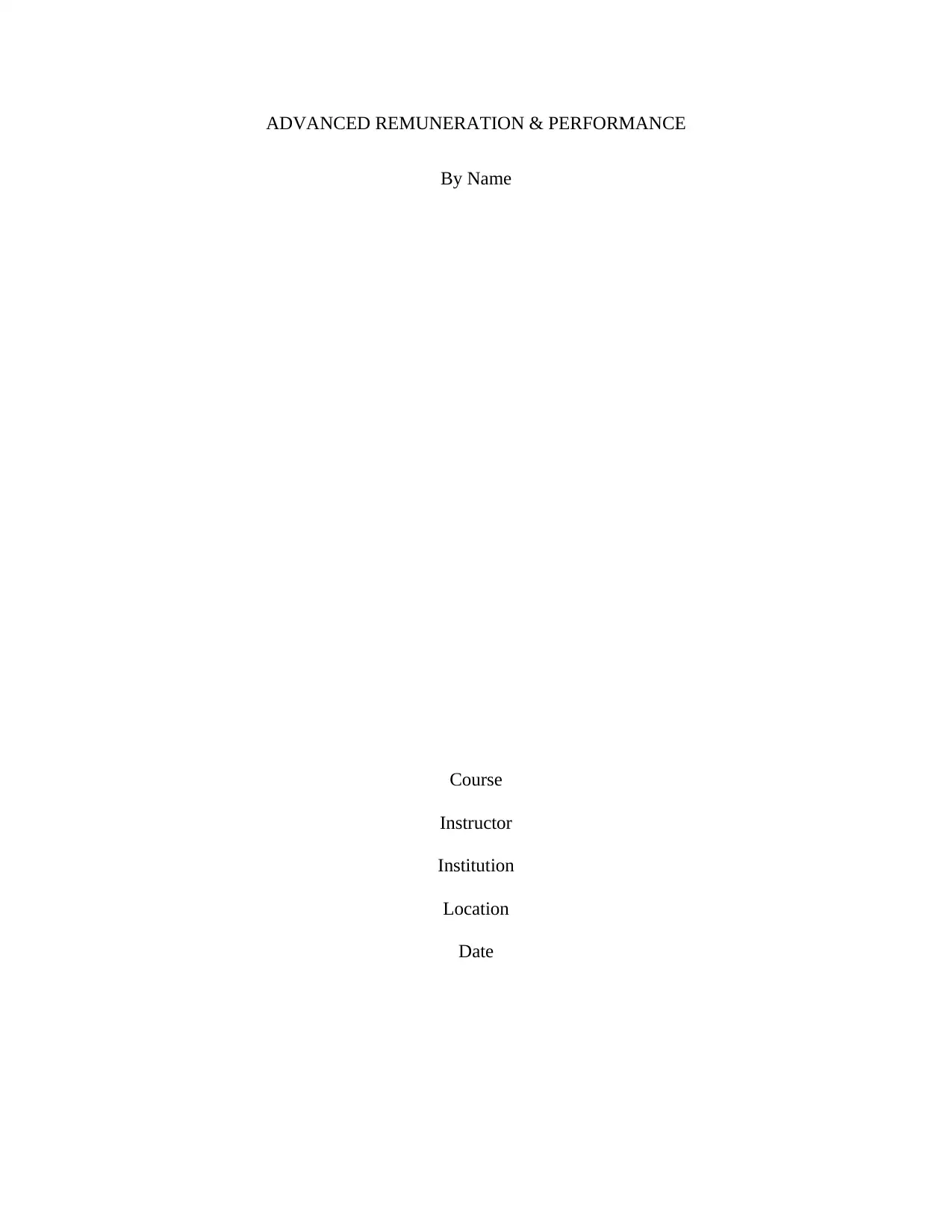
ADVANCED REMUNERATION & PERFORMANCE
By Name
Course
Instructor
Institution
Location
Date
By Name
Course
Instructor
Institution
Location
Date
Secure Best Marks with AI Grader
Need help grading? Try our AI Grader for instant feedback on your assignments.
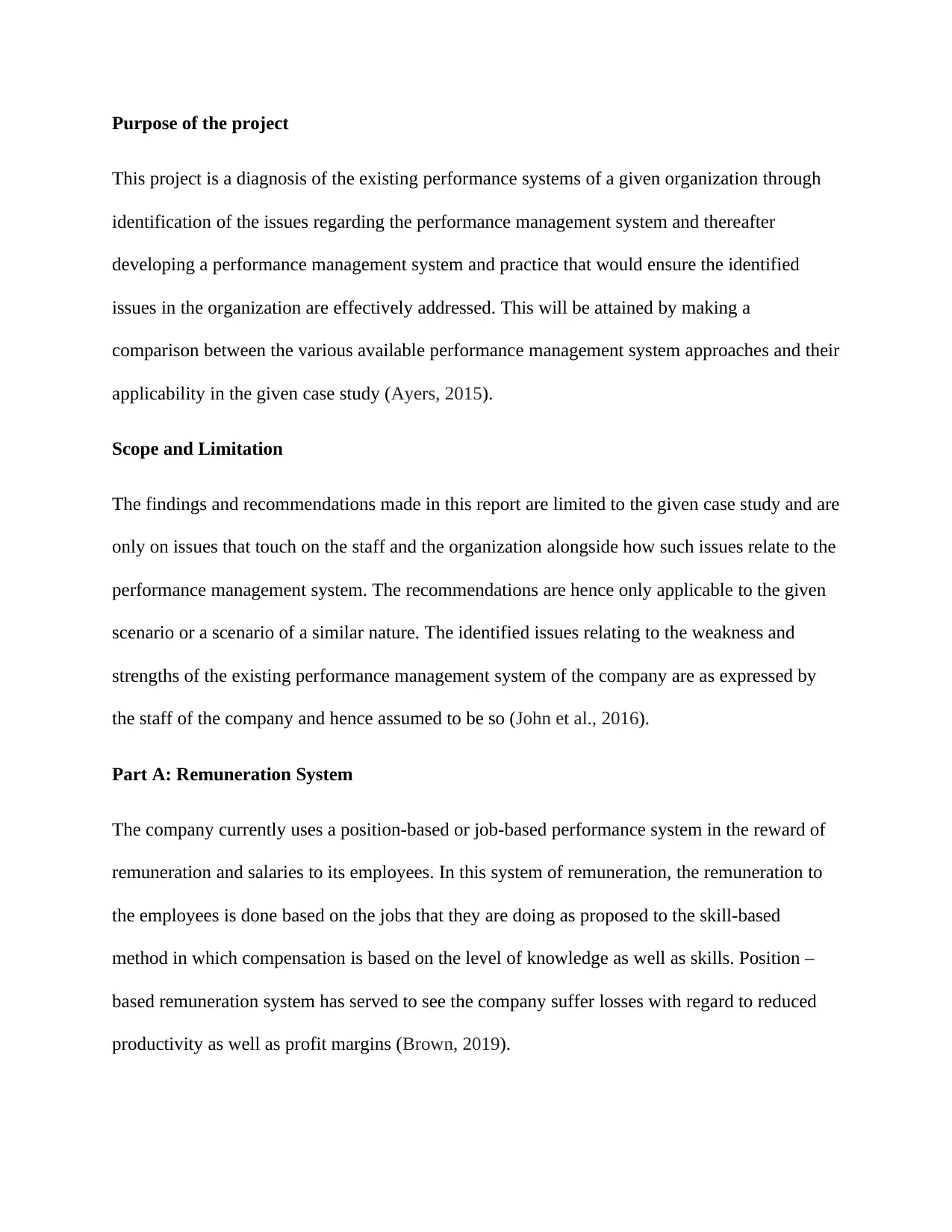
Purpose of the project
This project is a diagnosis of the existing performance systems of a given organization through
identification of the issues regarding the performance management system and thereafter
developing a performance management system and practice that would ensure the identified
issues in the organization are effectively addressed. This will be attained by making a
comparison between the various available performance management system approaches and their
applicability in the given case study (Ayers, 2015).
Scope and Limitation
The findings and recommendations made in this report are limited to the given case study and are
only on issues that touch on the staff and the organization alongside how such issues relate to the
performance management system. The recommendations are hence only applicable to the given
scenario or a scenario of a similar nature. The identified issues relating to the weakness and
strengths of the existing performance management system of the company are as expressed by
the staff of the company and hence assumed to be so (John et al., 2016).
Part A: Remuneration System
The company currently uses a position-based or job-based performance system in the reward of
remuneration and salaries to its employees. In this system of remuneration, the remuneration to
the employees is done based on the jobs that they are doing as proposed to the skill-based
method in which compensation is based on the level of knowledge as well as skills. Position –
based remuneration system has served to see the company suffer losses with regard to reduced
productivity as well as profit margins (Brown, 2019).
This project is a diagnosis of the existing performance systems of a given organization through
identification of the issues regarding the performance management system and thereafter
developing a performance management system and practice that would ensure the identified
issues in the organization are effectively addressed. This will be attained by making a
comparison between the various available performance management system approaches and their
applicability in the given case study (Ayers, 2015).
Scope and Limitation
The findings and recommendations made in this report are limited to the given case study and are
only on issues that touch on the staff and the organization alongside how such issues relate to the
performance management system. The recommendations are hence only applicable to the given
scenario or a scenario of a similar nature. The identified issues relating to the weakness and
strengths of the existing performance management system of the company are as expressed by
the staff of the company and hence assumed to be so (John et al., 2016).
Part A: Remuneration System
The company currently uses a position-based or job-based performance system in the reward of
remuneration and salaries to its employees. In this system of remuneration, the remuneration to
the employees is done based on the jobs that they are doing as proposed to the skill-based
method in which compensation is based on the level of knowledge as well as skills. Position –
based remuneration system has served to see the company suffer losses with regard to reduced
productivity as well as profit margins (Brown, 2019).
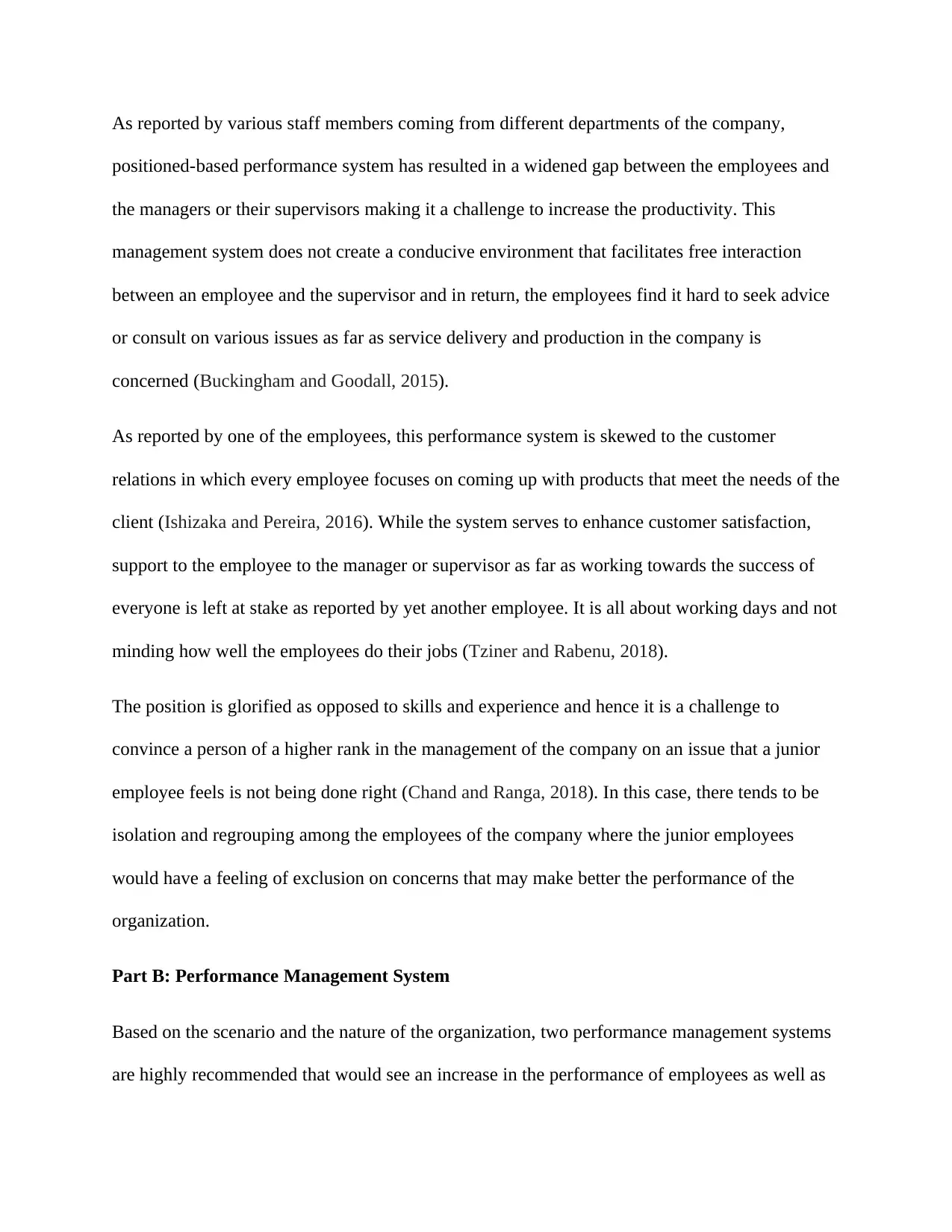
As reported by various staff members coming from different departments of the company,
positioned-based performance system has resulted in a widened gap between the employees and
the managers or their supervisors making it a challenge to increase the productivity. This
management system does not create a conducive environment that facilitates free interaction
between an employee and the supervisor and in return, the employees find it hard to seek advice
or consult on various issues as far as service delivery and production in the company is
concerned (Buckingham and Goodall, 2015).
As reported by one of the employees, this performance system is skewed to the customer
relations in which every employee focuses on coming up with products that meet the needs of the
client (Ishizaka and Pereira, 2016). While the system serves to enhance customer satisfaction,
support to the employee to the manager or supervisor as far as working towards the success of
everyone is left at stake as reported by yet another employee. It is all about working days and not
minding how well the employees do their jobs (Tziner and Rabenu, 2018).
The position is glorified as opposed to skills and experience and hence it is a challenge to
convince a person of a higher rank in the management of the company on an issue that a junior
employee feels is not being done right (Chand and Ranga, 2018). In this case, there tends to be
isolation and regrouping among the employees of the company where the junior employees
would have a feeling of exclusion on concerns that may make better the performance of the
organization.
Part B: Performance Management System
Based on the scenario and the nature of the organization, two performance management systems
are highly recommended that would see an increase in the performance of employees as well as
positioned-based performance system has resulted in a widened gap between the employees and
the managers or their supervisors making it a challenge to increase the productivity. This
management system does not create a conducive environment that facilitates free interaction
between an employee and the supervisor and in return, the employees find it hard to seek advice
or consult on various issues as far as service delivery and production in the company is
concerned (Buckingham and Goodall, 2015).
As reported by one of the employees, this performance system is skewed to the customer
relations in which every employee focuses on coming up with products that meet the needs of the
client (Ishizaka and Pereira, 2016). While the system serves to enhance customer satisfaction,
support to the employee to the manager or supervisor as far as working towards the success of
everyone is left at stake as reported by yet another employee. It is all about working days and not
minding how well the employees do their jobs (Tziner and Rabenu, 2018).
The position is glorified as opposed to skills and experience and hence it is a challenge to
convince a person of a higher rank in the management of the company on an issue that a junior
employee feels is not being done right (Chand and Ranga, 2018). In this case, there tends to be
isolation and regrouping among the employees of the company where the junior employees
would have a feeling of exclusion on concerns that may make better the performance of the
organization.
Part B: Performance Management System
Based on the scenario and the nature of the organization, two performance management systems
are highly recommended that would see an increase in the performance of employees as well as
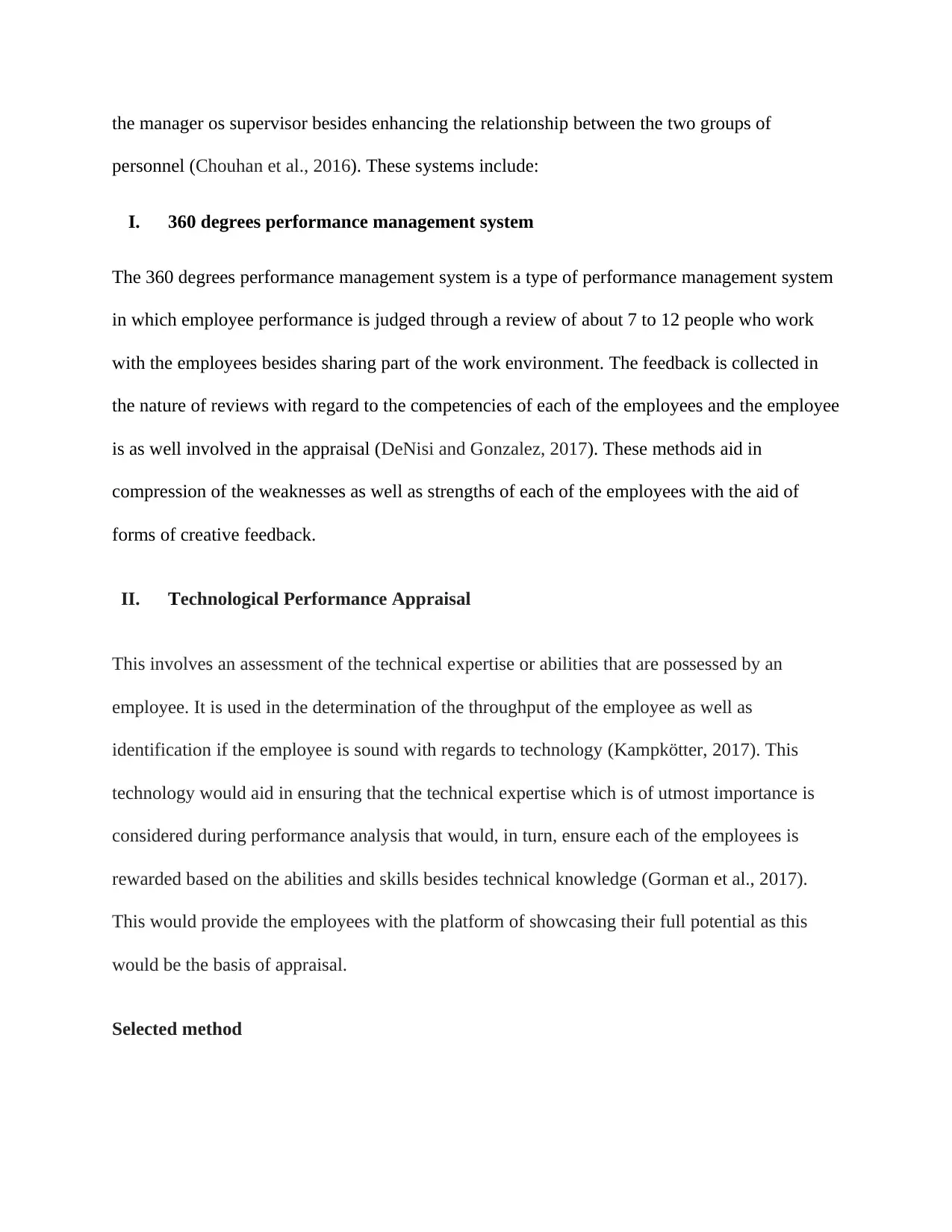
the manager os supervisor besides enhancing the relationship between the two groups of
personnel (Chouhan et al., 2016). These systems include:
I. 360 degrees performance management system
The 360 degrees performance management system is a type of performance management system
in which employee performance is judged through a review of about 7 to 12 people who work
with the employees besides sharing part of the work environment. The feedback is collected in
the nature of reviews with regard to the competencies of each of the employees and the employee
is as well involved in the appraisal (DeNisi and Gonzalez, 2017). These methods aid in
compression of the weaknesses as well as strengths of each of the employees with the aid of
forms of creative feedback.
II. Technological Performance Appraisal
This involves an assessment of the technical expertise or abilities that are possessed by an
employee. It is used in the determination of the throughput of the employee as well as
identification if the employee is sound with regards to technology (Kampkötter, 2017). This
technology would aid in ensuring that the technical expertise which is of utmost importance is
considered during performance analysis that would, in turn, ensure each of the employees is
rewarded based on the abilities and skills besides technical knowledge (Gorman et al., 2017).
This would provide the employees with the platform of showcasing their full potential as this
would be the basis of appraisal.
Selected method
personnel (Chouhan et al., 2016). These systems include:
I. 360 degrees performance management system
The 360 degrees performance management system is a type of performance management system
in which employee performance is judged through a review of about 7 to 12 people who work
with the employees besides sharing part of the work environment. The feedback is collected in
the nature of reviews with regard to the competencies of each of the employees and the employee
is as well involved in the appraisal (DeNisi and Gonzalez, 2017). These methods aid in
compression of the weaknesses as well as strengths of each of the employees with the aid of
forms of creative feedback.
II. Technological Performance Appraisal
This involves an assessment of the technical expertise or abilities that are possessed by an
employee. It is used in the determination of the throughput of the employee as well as
identification if the employee is sound with regards to technology (Kampkötter, 2017). This
technology would aid in ensuring that the technical expertise which is of utmost importance is
considered during performance analysis that would, in turn, ensure each of the employees is
rewarded based on the abilities and skills besides technical knowledge (Gorman et al., 2017).
This would provide the employees with the platform of showcasing their full potential as this
would be the basis of appraisal.
Selected method
Secure Best Marks with AI Grader
Need help grading? Try our AI Grader for instant feedback on your assignments.
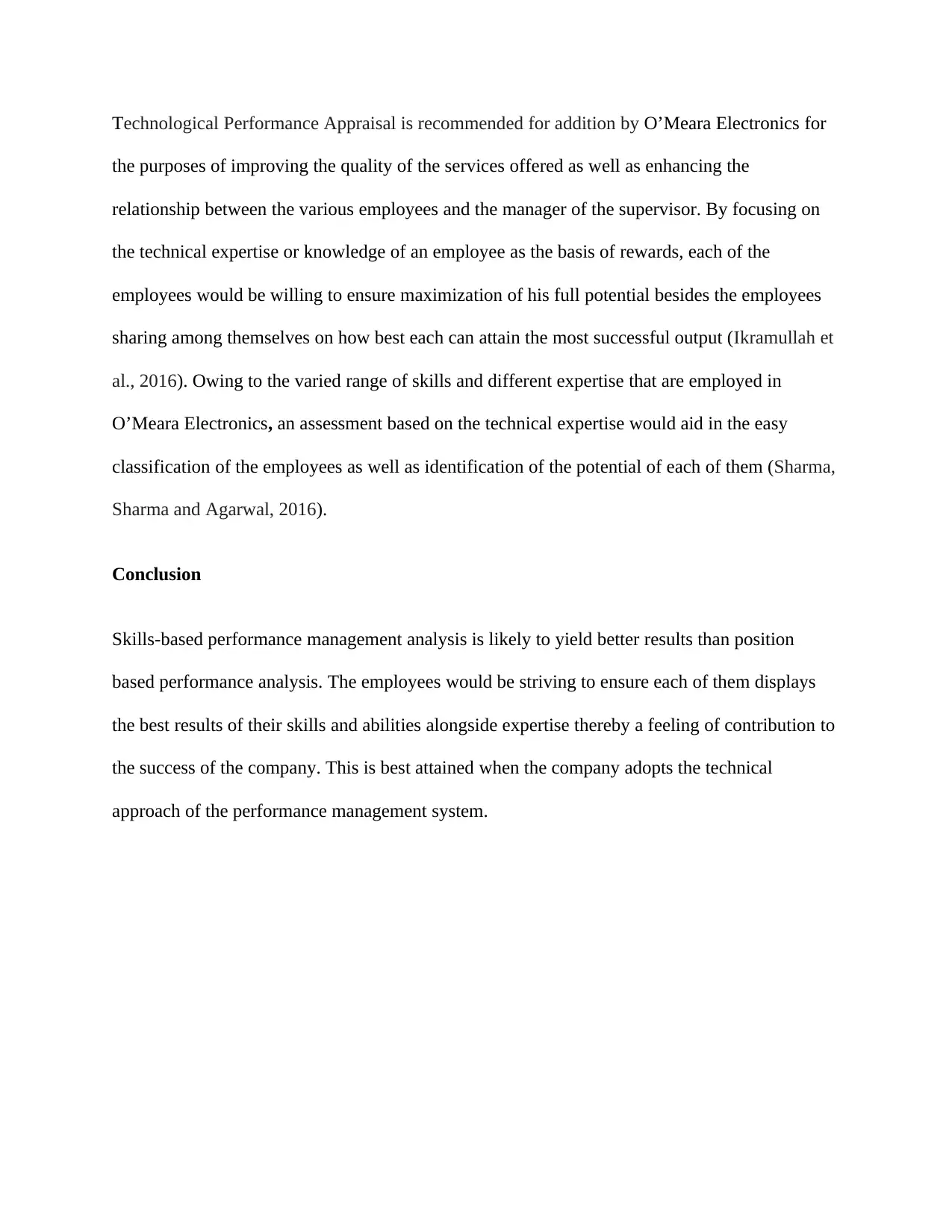
Technological Performance Appraisal is recommended for addition by O’Meara Electronics for
the purposes of improving the quality of the services offered as well as enhancing the
relationship between the various employees and the manager of the supervisor. By focusing on
the technical expertise or knowledge of an employee as the basis of rewards, each of the
employees would be willing to ensure maximization of his full potential besides the employees
sharing among themselves on how best each can attain the most successful output (Ikramullah et
al., 2016). Owing to the varied range of skills and different expertise that are employed in
O’Meara Electronics, an assessment based on the technical expertise would aid in the easy
classification of the employees as well as identification of the potential of each of them (Sharma,
Sharma and Agarwal, 2016).
Conclusion
Skills-based performance management analysis is likely to yield better results than position
based performance analysis. The employees would be striving to ensure each of them displays
the best results of their skills and abilities alongside expertise thereby a feeling of contribution to
the success of the company. This is best attained when the company adopts the technical
approach of the performance management system.
the purposes of improving the quality of the services offered as well as enhancing the
relationship between the various employees and the manager of the supervisor. By focusing on
the technical expertise or knowledge of an employee as the basis of rewards, each of the
employees would be willing to ensure maximization of his full potential besides the employees
sharing among themselves on how best each can attain the most successful output (Ikramullah et
al., 2016). Owing to the varied range of skills and different expertise that are employed in
O’Meara Electronics, an assessment based on the technical expertise would aid in the easy
classification of the employees as well as identification of the potential of each of them (Sharma,
Sharma and Agarwal, 2016).
Conclusion
Skills-based performance management analysis is likely to yield better results than position
based performance analysis. The employees would be striving to ensure each of them displays
the best results of their skills and abilities alongside expertise thereby a feeling of contribution to
the success of the company. This is best attained when the company adopts the technical
approach of the performance management system.
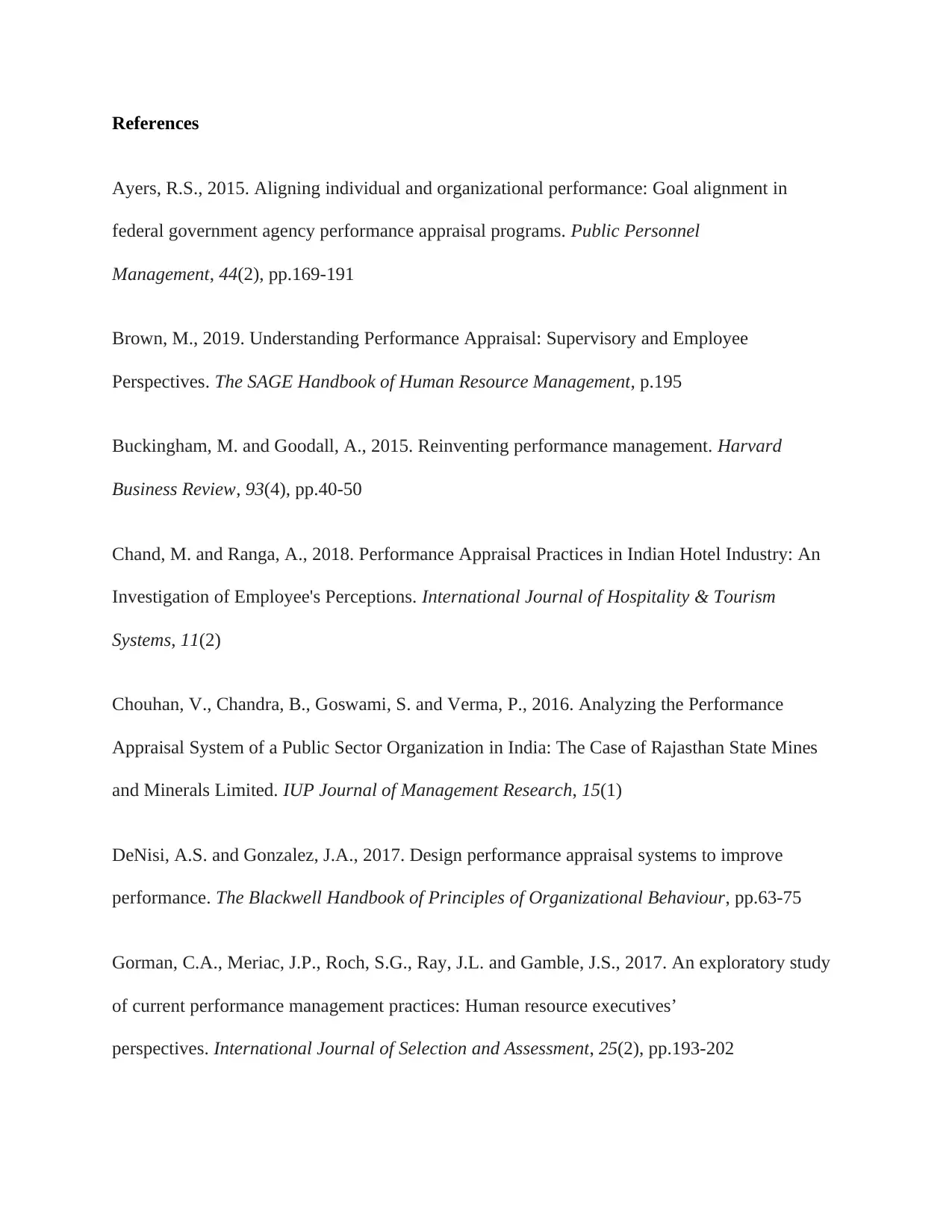
References
Ayers, R.S., 2015. Aligning individual and organizational performance: Goal alignment in
federal government agency performance appraisal programs. Public Personnel
Management, 44(2), pp.169-191
Brown, M., 2019. Understanding Performance Appraisal: Supervisory and Employee
Perspectives. The SAGE Handbook of Human Resource Management, p.195
Buckingham, M. and Goodall, A., 2015. Reinventing performance management. Harvard
Business Review, 93(4), pp.40-50
Chand, M. and Ranga, A., 2018. Performance Appraisal Practices in Indian Hotel Industry: An
Investigation of Employee's Perceptions. International Journal of Hospitality & Tourism
Systems, 11(2)
Chouhan, V., Chandra, B., Goswami, S. and Verma, P., 2016. Analyzing the Performance
Appraisal System of a Public Sector Organization in India: The Case of Rajasthan State Mines
and Minerals Limited. IUP Journal of Management Research, 15(1)
DeNisi, A.S. and Gonzalez, J.A., 2017. Design performance appraisal systems to improve
performance. The Blackwell Handbook of Principles of Organizational Behaviour, pp.63-75
Gorman, C.A., Meriac, J.P., Roch, S.G., Ray, J.L. and Gamble, J.S., 2017. An exploratory study
of current performance management practices: Human resource executives’
perspectives. International Journal of Selection and Assessment, 25(2), pp.193-202
Ayers, R.S., 2015. Aligning individual and organizational performance: Goal alignment in
federal government agency performance appraisal programs. Public Personnel
Management, 44(2), pp.169-191
Brown, M., 2019. Understanding Performance Appraisal: Supervisory and Employee
Perspectives. The SAGE Handbook of Human Resource Management, p.195
Buckingham, M. and Goodall, A., 2015. Reinventing performance management. Harvard
Business Review, 93(4), pp.40-50
Chand, M. and Ranga, A., 2018. Performance Appraisal Practices in Indian Hotel Industry: An
Investigation of Employee's Perceptions. International Journal of Hospitality & Tourism
Systems, 11(2)
Chouhan, V., Chandra, B., Goswami, S. and Verma, P., 2016. Analyzing the Performance
Appraisal System of a Public Sector Organization in India: The Case of Rajasthan State Mines
and Minerals Limited. IUP Journal of Management Research, 15(1)
DeNisi, A.S. and Gonzalez, J.A., 2017. Design performance appraisal systems to improve
performance. The Blackwell Handbook of Principles of Organizational Behaviour, pp.63-75
Gorman, C.A., Meriac, J.P., Roch, S.G., Ray, J.L. and Gamble, J.S., 2017. An exploratory study
of current performance management practices: Human resource executives’
perspectives. International Journal of Selection and Assessment, 25(2), pp.193-202
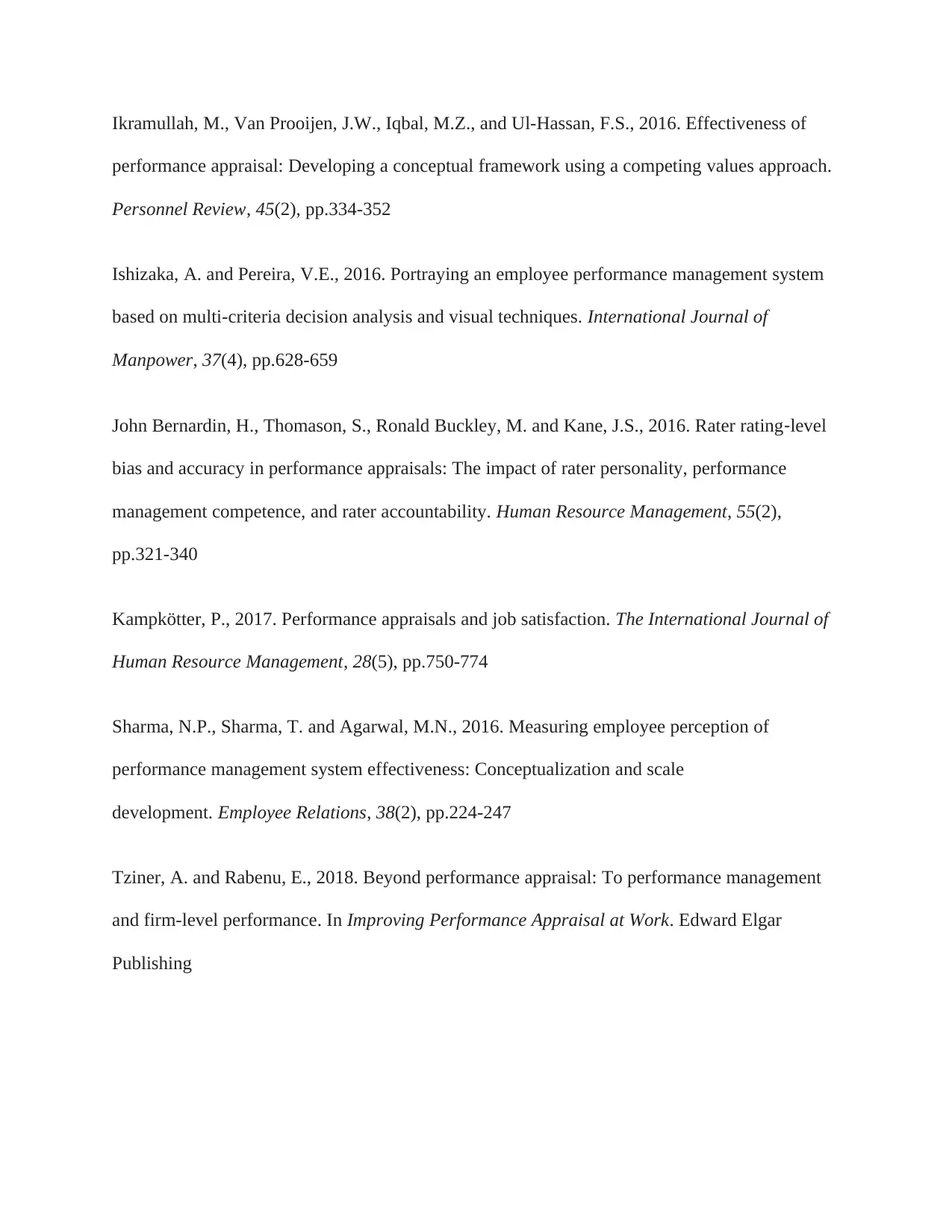
Ikramullah, M., Van Prooijen, J.W., Iqbal, M.Z., and Ul-Hassan, F.S., 2016. Effectiveness of
performance appraisal: Developing a conceptual framework using a competing values approach.
Personnel Review, 45(2), pp.334-352
Ishizaka, A. and Pereira, V.E., 2016. Portraying an employee performance management system
based on multi-criteria decision analysis and visual techniques. International Journal of
Manpower, 37(4), pp.628-659
John Bernardin, H., Thomason, S., Ronald Buckley, M. and Kane, J.S., 2016. Rater rating‐level
bias and accuracy in performance appraisals: The impact of rater personality, performance
management competence, and rater accountability. Human Resource Management, 55(2),
pp.321-340
Kampkötter, P., 2017. Performance appraisals and job satisfaction. The International Journal of
Human Resource Management, 28(5), pp.750-774
Sharma, N.P., Sharma, T. and Agarwal, M.N., 2016. Measuring employee perception of
performance management system effectiveness: Conceptualization and scale
development. Employee Relations, 38(2), pp.224-247
Tziner, A. and Rabenu, E., 2018. Beyond performance appraisal: To performance management
and firm-level performance. In Improving Performance Appraisal at Work. Edward Elgar
Publishing
performance appraisal: Developing a conceptual framework using a competing values approach.
Personnel Review, 45(2), pp.334-352
Ishizaka, A. and Pereira, V.E., 2016. Portraying an employee performance management system
based on multi-criteria decision analysis and visual techniques. International Journal of
Manpower, 37(4), pp.628-659
John Bernardin, H., Thomason, S., Ronald Buckley, M. and Kane, J.S., 2016. Rater rating‐level
bias and accuracy in performance appraisals: The impact of rater personality, performance
management competence, and rater accountability. Human Resource Management, 55(2),
pp.321-340
Kampkötter, P., 2017. Performance appraisals and job satisfaction. The International Journal of
Human Resource Management, 28(5), pp.750-774
Sharma, N.P., Sharma, T. and Agarwal, M.N., 2016. Measuring employee perception of
performance management system effectiveness: Conceptualization and scale
development. Employee Relations, 38(2), pp.224-247
Tziner, A. and Rabenu, E., 2018. Beyond performance appraisal: To performance management
and firm-level performance. In Improving Performance Appraisal at Work. Edward Elgar
Publishing
1 out of 7
Related Documents
Your All-in-One AI-Powered Toolkit for Academic Success.
+13062052269
info@desklib.com
Available 24*7 on WhatsApp / Email
![[object Object]](/_next/static/media/star-bottom.7253800d.svg)
Unlock your academic potential
© 2024 | Zucol Services PVT LTD | All rights reserved.




